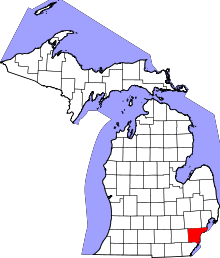First Congregational Church (Detroit, Michigan)
|
First Congregational Church | |
|
First Congregational Church from across Woodward | |
| Location |
33 East Forest Avenue Detroit, Michigan |
|---|---|
| Coordinates | 42°21′19″N 83°3′46″W / 42.35528°N 83.06278°WCoordinates: 42°21′19″N 83°3′46″W / 42.35528°N 83.06278°W |
| Built | 1891; 1921 (addition) |
| Architect | John Lyman Faxon; Albert Kahn |
| Architectural style | Romanesque Revival |
| NRHP Reference # | 79001173[1] |
| Significant dates | |
| Added to NRHP | June 04, 1979 |
| Designated MSHS | July 26, 1974[2] |
The First Congregational Church is located at 33 East Forest Avenue (on the corner of Forest and Woodward Avenue) in Midtown Detroit, Michigan. It was designated a Michigan State Historic Site in 1974[2] and listed on the National Register of Historic Places in 1979.[1]
History
The First Congregational Church of Detroit was established on December 25, 1844. Two church buildings were built near the Detroit River. The third building was constructed at the present site in 1891, and was designed by architect John Lyman Faxon. An addition to the church, known as the Angel's Wing, was constructed in 1921 by Albert Kahn.[3]
Architecture
The church is designed in a blend of the Romanesque and Byzantine styles,[4] using rough-hewn, warm red limestone. The Woodward facade has a five-bay loggia, with a parapeted front gable. Above that are rounded windows with tracery framed by a rounded arch. The church also features a 120-foot campanile with many narrow arcades. The church is topped by an 8-foot copper figure of the Archangel Uriel.[5]
The church is patterned after churches found in Venice and Ravenna. The sanctuary, which resembles the lower church of St. Francis of Assisi,[4] boasts carved wood, ceiling portraits, rose windows and sumptuous colors.[3]
First Congregational Living Museum
The church offers exhibits about the historical and architectural aspects of the church, its buildings and activities. Visitors can go on self-guided tours of the historic facilities and buildings.
The church also hosts the Underground Railroad Living Museum, a storytelling simulation of the original Underground Railroad.
Gallery
 First Congregational Church, c. 1899
First Congregational Church, c. 1899 First Congregational Church, c. 1903
First Congregational Church, c. 1903 The angel Uriel atop the First Congregational Church
The angel Uriel atop the First Congregational Church
References
- 1 2 National Park Service (2007-01-23). "National Register Information System". National Register of Historic Places. National Park Service.
- 1 2 "First Congregational Church". Michigan State Housing Development Authority. Retrieved September 2, 2010.
- 1 2 First Congregational Church of Detroit History page
- 1 2 Tutag, Nola Huse, & Hamilton, Lucy (1987). Discovering Stained Glass in Detroit, p. 57. Wayne State University Press.
- ↑ First Congregational Church from Detroit1701
| Wikimedia Commons has media related to First Congregational Church (Detroit, Michigan). |
.jpg)

